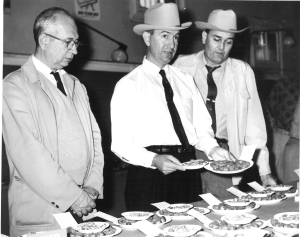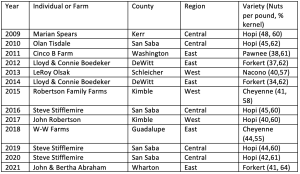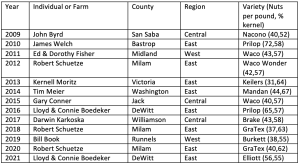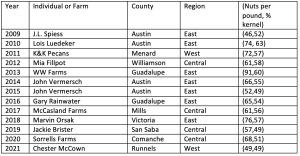In Search of Texas’ Best Pecans
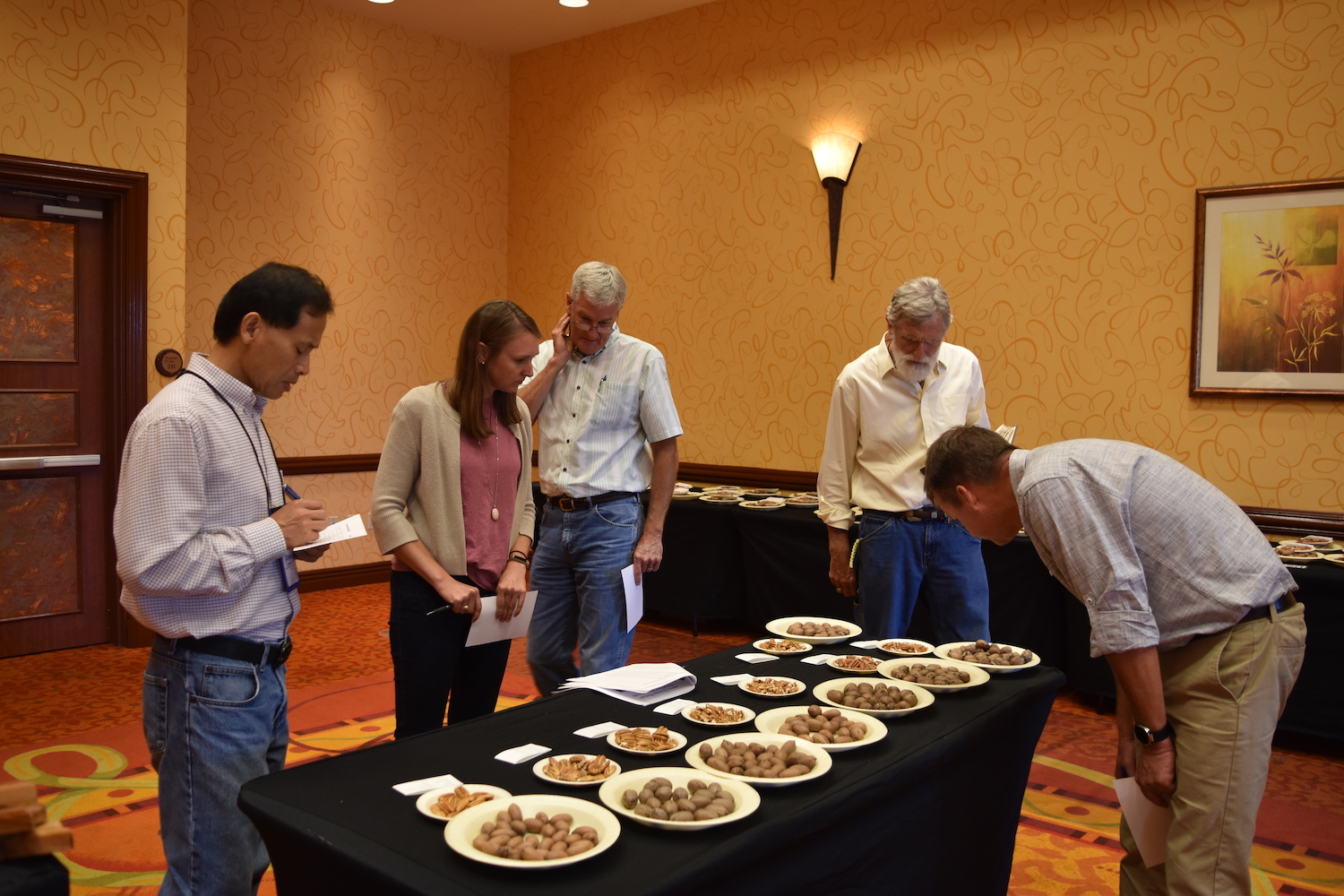
Judges for the 2018 Texas Pecan Show examine entries and select the Texas Grand Champions for the 2018 crop. (Photo by Catherine Clark)
Pecan is relatively young in its journey of domestication compared to many other fruit and nut crops. Whereas the English Walnut or “Persia Nut” (Juglans regia) is believed to have been introduced to Greece from Persia as a cultivated crop by Alexander the Great around 335 BC, the pecan is not described in written history until 1535 AD and then only as a wild North American nut. The first grafting of a pecan tree, which allowed a unique variety to be duplicated, multiplied, and planted in new locations, did not happen until about 1870 when an enslaved Creole American man named Antoine grafted a variety of pecan, later called ‘Centennial,’ at Oak Alley Plantation. Prior to this successful graft, all pecan commerce, marketing, and discussions were a competition that likely began with or included the phrase, “I have a pecan that is better than yours.” Historical notes tell us that indigenous people in Texas and elsewhere not only sought and found those wild pecan trees with superior nut-eating traits but claimed them and warned other people to go find their own good pecan tree.
E.E. Risien, an English immigrant to Texas, motivated by his own interest in finding and reproducing a better native pecan, hosted a pecan competition in the San Saba area in the late 1800s with folks bringing nuts they collected to show and tell who had the best. Risien tracked down the tree that won the competition, bought the land with the tree, and began to attempt duplicating and improving from what is known as the “Mother San Saba Tree.”
According to the Texas A&M Forest Service, “Records of the first meeting of the Texas State Horticultural Society, held in Brenham in 1886, indicate that Risien won the honor of showing the best plate of pecans.” ‘Western Schley,’ one of the most widely grown varieties in the arid West today, originated with Risien’s work that started at a pecan show. Pecan shows therefore were critical vehicles in the early to mid 1900s that encouraged the discovery and sharing of superior pecans at a time when natives predominated the fledgling pecan industry, grafting methods were being perfected, and intentional breeding of new varieties began.
Seeing the benefit of pecan shows to pecan variety discovery and dissemination, the TPGA Board of Directors passed a motion to hold a pecan show in the Fall of 1950. That show, displayed on the A&M College main campus (now Texas A&M University), was judged by the pecan experts of the day: Fred Brison, Al Krezdorn, Bluford Hancock, and John Hutchinson. The format, procedures, and categories evolved over time, but for 72 consecutive years, the Texas Pecan Show has been a platform to bring pecan growers, researchers, Extension agents, and geneticists together to share and learn what varieties performed the best, where in the state they did well, and which growers were successful with them.
How and When It Happens
The Texas Pecan Show grew in popularity in the 1960s and ‘70s to the point that it exceeded Texas A&M University’s capability to host it. About 1,027 sample plates of pecans filled the Memorial Student Center in 1965, a logistical challenge to display, judge, and take down. In 1969, Dr. George Ray McEachern, Extension Pecan Specialist, stepped in to lead and better organize the program. He computerized the process, published an annual guidebook to help Extension agents, and renamed it the “Texas Pecan Grading Demonstration” within the Extension agency for two reasons: to highlight the teaching tool it had become for properly grading and selling pecans, and because administrators in the 1970s began to frown on travel funds being used to attend “shows.”
With help from Robert Kensing, McEachern instituted the tri-level (county-regional-state) system of judging. Historically, pecans had to compete and win at a county show and then win at the regional (multi-county) level to compete at the state-level competition. In 2019, we began offering an at-large route for pecans to compete at regional and state for growers who don’t have a nearby county pecan show.
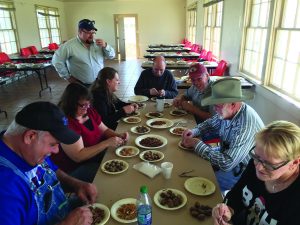
The cracking crew are preparing the samples from various counties entered in the West Regional Show. The winning entries in all varieties from each of the regional shows are forwarded to Texas A&M AgriLife headquarters in College Station, where they are put into cold storage until next July when the State Pecan Show takes place. Another round of judging will take place at that time and statewide winners will be determined.
Growers interested in competing for the first time should contact their local county agent to see if there is a local show, and if not, apply online through the form on the TPGA website’s Texas Pecan Show page. Note that this form also shows the 46 competitive categories, such as ‘Cheyenne,’ ‘Podsednik,’ Variety Seedlings, and Lightest Natives. During the first step of the competition, varieties are judged as a class, with ‘Desirable’ samples judged against other ‘Desirable’ samples only. Secondly, the judges identify the Grand and Reserve Champions within three divisions: Commercial, Classic & New, and Native.
County agents faithfully hosting county pecan shows have been pivotal to the successful history of this annual event. The camaraderie of local growers meeting to help their county agent crack, weigh, shell, and display the county pecan show is the heart and soul of it. “Talking pecans” may be more important to many people than the competition itself.
Yet, participation has declined in the last fifteen years, with fewer counties holding shows and some counties combining into multi-county clusters. Those counties that will hold pecan shows in 2022 include Abilene Area (Callahan, Jones, Fisher, Nolan; Taylor), Austin, Andrews, Bell, Comanche, Concho Valley (Concho, Runnels, Schleicher; Tom Green), DeWitt, Eastland, Fort Bend, Gillespie, Guadalupe, Jack, Menard, Milam, Palo Pinto, Pecos, San Saba, Ward, Washington, and Williamson. The three regional competitions (East, Central, and West) are being judged in College Station in January. The state competition is held in conjunction with the TPGA Annual Conference in July. In addition to providing the venue for the state-level Texas Pecan Show, TPGA also funds the awards and helps to promote the show and results.
The Texas Pecan Show has rules that are enforced at all three levels. Those can be found in the “Texas Pecan Grading Guidebook” on the TPGA website’s Texas Pecan Show page. There is no fee to enter, and all you need to compete is a 40-nut sample of pecans, all of the same variety (the same tree if native), entered by the grower or owner of the property in Texas. Winners at the regional and state levels receive ribbons for 1st, 2nd, and 3rd place in each variety category, and the grand champions win Texas-shaped, pecan-wood plaques. County-level awards are given at the discretion of each county agent.
What We’ve Learned in 71 Years of Competition
Sample selectivity matters. Growers serious about winning the Texas Pecan Show are careful with picking their 40-nut sample. Tedious weighing of individual nuts with a jeweler’s scale or sinking nuts in a water tank to find the heaviest are well-known methods to gain an advantage. Outward appearance matters, with shrewd competitors knowing that judges look at both the kernels and the inshell nuts for uniformity in size and freedom from signs of insect or disease damage. In the same way, individual growers have great influence over the market value of their crop simply by having good cleaning and grading equipment that will separate #1 and #2 kernels, etc., with air legs or other equipment.
Not all varieties are good ones. Genetics matters! After being entered for many years, ‘Podsednik,’ the world’s largest pecan, has taught us that its potential to produce good quality kernels is low. I’ve seen one sample of ‘Podsednik’ in the 13 years I’ve been Coordinator of the Texas Pecan Show that was decent, but the rest were only valuable for their outward hulking appearance. If serious pecan show participants can’t get Variety XYZ to produce good-quality pecans, I’ll tell you that it will likely be worse for the general population of growers in the state.
On the other hand, you can count on varieties like ‘Cheyenne,’ ‘Nacono,’ ‘Forkert,’ and ‘Hopi’ to deliver outstanding quality kernels nearly every year, as testified by their appearance in the champion tables presented here. Varieties with good genetics in the care of motivated growers can manifest an extremely attractive and highly nutritious product that has no marketing problems on the global stage. The Texas Pecan Show confirms that a high level of pecan quality is possible.
Just as Risien viewed a competition as an opportunity for discovering new pecans, the Texas Pecan Show is an ongoing process of variety introduction. The variety seedling and native pecan categories have served as launching pads for the grassroots adoption of varieties discovered outside of breeding programs. ‘Prilop,’ an exceptional native pecan from Lavaca County, became popular in the East Region in part from its pecan show performance. It went so far as to be named and given its own variety class in the competition. ‘Prilop’ even won the reserve champion “Classic & New” pecan in 2016, an impressive feat for a native pecan! Similarly, we have seen the introduction of new varieties like ‘Fayette’ and ‘Waco Wonder’ that were discovered and entered in the Variety Seedling or Other Pecan categories by pecan show competitors.
Exceptional quality is attainable every year! Weather and pest issues can be important determinants of pecan kernel quality at the county level. I’ve seen certain counties in Texas have bad years, with fewer samples entered into the competition and lower quality overall. Yet elsewhere in the state in the same year, the opposite may be true. The Texas pecan industry is dispersed across a wide geographic area with diverse ecoregions that encounter their fair share of triumphs and disasters over time. Among the state grand champions across three show divisions, 18 counties in Texas are represented from 2009 to 2021 (Tables 1-3), with 20 champions coming from the East Region, 12 from the Central, and seven from the West. Of course, the 13 years shown here are only one snapshot of our 71 years of records.
The Competitors
The Texas Pecan Show has a successful 72-year history because of the men and women who have been loyal participants and motivated competitors. Some are large commercial growers, like Belding Farms in Pecos County, and some are small growers with just an acre or two, like Mr. Robert Schuetze near Cameron. Some may enter only one improved variety, seedling, or native they have year after year. We also have pecan variety enthusiasts, collectors, who enter several each year, intent on winning but equally interested in helping the tremendous diversity of pecan nuts be given the attention it deserves. From 1974 to 2009, 18 individual growers had 50 or more entries at the state pecan show. This loyalty of participation has kept the Texas Pecan Show interesting, challenging, and educational over the years.
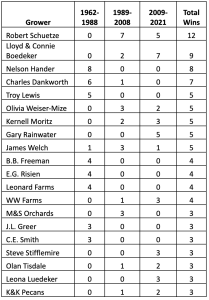
Table 5—Pecan growers in Texas with three or more Grand or Reserve Champion awards at the Texas State Pecan Show, 1962-2021.
In the 2021 state show, 80 different growers were represented, totaling 200 entries. Some entries don’t make it out of their county show, and some don’t compete beyond regional. The state show represents the best of the best, and to win one of the three state Grand Champion awards at the Texas Pecan Show is a great achievement! Our judging is strict and fair, and there is no doubt that the Grand Champion was the best pecan in Texas that year. It’s not easy to win Grand Champion at this state competition, and lots of people have tried unsuccessfully. Yet you can see repeat grand champions in summary tables 1-3 that cover the 13 most recent years on record. Even more impressive are the accomplishments of those men and women who’ve won three or more times (Table 5). Mr. Robert Schuetze and Mr. Lloyd Boedeker, two current pecan growers in the East Region, won an incredible 12 and 9 times, respectively, the two highest among all Texas Pecan Show participants going back to 1962!
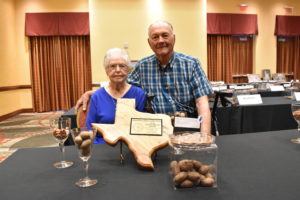
Doris and Robert Schuetze pose with their winning pecans at the 2020 State Pecan Show on display at TPGA’s 100th Conference and Trade Show. The Schuetzes currently hold the most wins in Texas Pecan Show history.
Winning multiple times is not luck. It demonstrates a mastery of pecan knowledge and practice that even those of us in the scientific community can benefit from. We all want to grow high-quality pecans, and here are people who have extracted the very highest quality from their pecan trees again and again!
Why Compete in 2022?
If you’re a pecan grower in Texas and you’ve never competed in the Texas Pecan Show, a new opportunity awaits this Fall. County pecan shows generally begin in late November, so contact your local office to find out the appropriate dates. If your county does not have a show, contact a neighboring county that does. Many will be happy for you to compete there. Otherwise, at-large entries must be sent to the TPGA office by Jan. 1, 2023.
What are the benefits of competing? First, the county pecan shows are great networking opportunities. Learning what other growers in the county did or didn’t do to produce a crop can be very valuable. This networking happens at the regional and state levels also, and we welcome volunteers to work with us at every level. Second, get a free expert opinion on how good your pecans are. That’s valuable information and feedback on how to improve. You may even learn your pecans are not the variety you thought they were. Every year, we reclassify many pecan show samples that were improperly identified. Third, participants contribute to the knowledge base of pecan variety performance in Texas. The samples we receive are a feedback mechanism to Extension specialists and the USDA Pecan Breeding scientists for what varieties are successful against the climatic challenges in Texas. We’re all working together to find better pecans. Finally, you can’t win if you don’t compete. Pecan growing is an arduous 210-plus-day process. Why not get rewarded for your efforts, take home bragging rights, and hang some bling in your shop that can help you market your pecans for a higher price?

